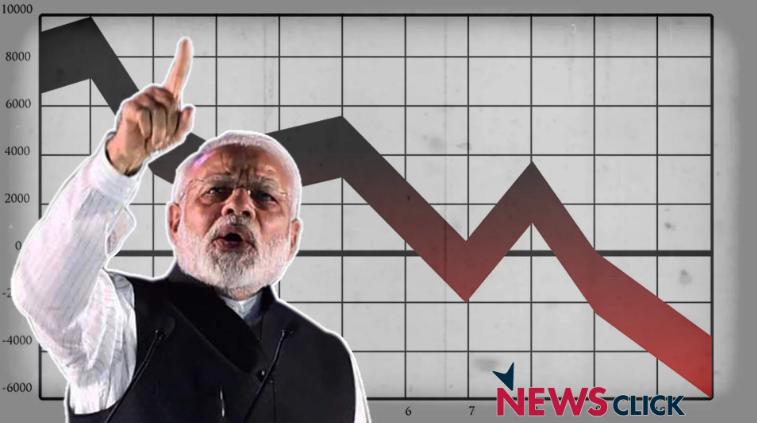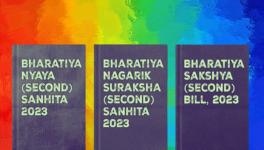The Mendacity of Modi Govt’s ‘Rescue Package’

The inhumanity of the Narendra Modi government towards the people is matched only by its mendacity. And in both respects the Modi government is far ahead of most other governments in the world. Which other government would have passed off a slew of concessions to foreign and domestic monopolists as a “rescue package” for the people of the country? Which other government would have totted up loan plans for banks, and non-bank financial companies, as succour to the crisis-hit poor? Which other government would have projected abject prostration before globalised finance (and its credit-rating agencies) as a move towards self-reliance?
Let us start at the beginning. Having declared a lockdown with a notice of only four hours, sparing not a thought for the 14 crore migrant workers who were rendered homeless, without incomes, and without food at one stroke, and hence poured out in vast numbers onto the streets to go back to the only refuge they knew, namely their village homes, the Modi government announced belatedly a “rescue package” of Rs.1.7 lakh crore. Of this, however, fresh assistance not already in the Union Budget, amounted only to Rs.92,000 crore or less than 0.5% of the country’s gross domestic product or GDP, far lower than of every other major country in the world.
Despite the lockdown getting extended for over a month subsequently, and the tragedy of migrant workers trudging home in desperation being broadcast daily across the entire world, there was not a whimper from the Modi government.
Then on May 12, Modi announced a package of Rs.20 lakh crore, including all earlier announcements. This at least sounded substantial; its details were to be spelt out subsequently by the Finance Minister. She duly did so; and it turned out that the so-called “rescue package” of Rs.20 lakh crore was sheer bombastry of the highest order. The bulk of the financial assistance promised by the government was in the form of loan offers, to peasants, to medium, small and micro enterprises or MSMEs and other affected sectors.
It is difficult to cut through the miasma of announcements to get at an exact figure for the fiscal support the package provides. From estimates by independent researchers, I calculate the total expenditure from the government’s budget, or fiscal transfers, which alone should qualify as “rescue package” to be a paltry Rs.1.9 lakh crore, though some researchers have estimated an even lower figure of Rs.1.65 lakh crore (The Wire, May 18). Since this includes all earlier packages, it is the total amount of government expenditure in the context of the pandemic, and it comes to about 1% of the country’s GDP, a ridiculous sum compared both with the scale of the massive humanitarian crisis we are facing and also to what other countries are spending.
Two bits of information sum up the paltriness of the latest measures. The first relates to what is about the only provision for migrant workers in the latest measures, namely, 5 kilograms of free extra foodgrains per head, and for which the government would spend all of Rs.3,500 crore, i.e. Rs. 250 per head of the 14 crore migrant population; even taking the government’s own figure of eight crore migrant workers, it comes to Rs. 437.5 per capita. This is the total extent of the government’s sympathy for the migrants!
The second relates to the sum of Rs.6,750 crore, which is supposed to help 4.3 crore workers, whose statutory provident fund deduction has been reduced from 12% to 10% for the next three months; the government is so desperate that it claims this as part of its package!
Government officials have been at pains to explain away the utter miserliness of this package by saying that a “package” always includes both fiscal and monetary policy measures, without referring to the “mix” between the two. This remark reminds one of war-time Britain when sandwiches containing a “mix” of horse and chicken meats were given to the population; the “mix” of the two meats was supposed to be 1:1, which turned out to be one horse to one chicken!
Apart from the paltriness of the fiscal transfer, what is striking about the package is its utter mindlessness. Mindlessness always underlies disdain towards the people; and this is a clear instance of it. It is by now accepted universally by the knowledgeable that the problem with the Indian economy is a severe intensification of the shortage of demand, which already was a feature of the pre-pandemic situation.
With nearly a quarter of the entire workforce currently unemployed and hence without any purchasing power, this is hardly surprising. And unless demand is generated, simply providing credit to enterprises will be of no use; they will take credit for their working capital only when they want to produce more, for which, however, there has to be demand. But the government’s package entails a minuscule order of government spending, which alone could generate demand; its offer of more credit, therefore, will simply go a-begging.
What was needed at this stage, therefore, was not greater offer of bank credit to private producers, but greater bank credit to the government to spend. By spending on transfer payments to the distressed, as many, above all the Left parties, have suggested, the government could have killed two birds with one stone: generated demand and also alleviated distress. Such a revival of demand would then have brought about output expansion and for sustaining such an expansion there would have been greater private demand for bank credit.
But, by simply keeping government expenditure out of this, and offering bank credit to private producers, the government has ensured that there would be little genuine demand for bank credit. The package, in other words, neither alleviates distress, nor generates demand, nor actually increases bank lending.
Why has the government offered such a useless package? Here we have to bring in another factor which is enmeshed with the government’s mindlessness; and that is its desire to kow-tow to international finance capital. The reason why it is so niggardly with its spending is that its fiscal deficit will then increase, the credit-rating agencies might downgrade its status, and this might make globalised finance leave the country.
The Modi government does not have the gumption in such an eventuality to impose controls on financial outflows; it would rather surrender to finance, which it has done by reining in its own expenditure, and this is also in keeping with its callousness toward the poor.
In short, in the conflict between the interests of the people and the dictates of globalised finance, the Modi government has firmly sided with globalised finance. Ironically, this very government talks of building a self-reliant economy, indeed uses the rhetoric of self-reliance to camouflage its prostrating itself before globalised finance.
The dialectics of this process is noteworthy. The conflict between the dictates of globalised finance and the interests of the working people, characterises the entire era of globalisation. But as long as economies like India were growing relatively fast, this conflict could be somehow camouflaged, and the hegemony of globalised finance could remain unchallenged, by pretending that “growth” would make everybody better off eventually. Though it never did so, and the working people became actually worse off in the era of neo-liberal globalisation, this myth could still be sustained, that things would be different tomorrow if the rapid growth continued. But with the crisis of world capitalism, and of the Indian economy along with it, this conflict can no longer be camouflaged. The pandemic has everywhere brought this conflict to a head.
In many countries, governments have come out with rescue-cum-relief packages involving substantial government spending, financed by fiscal deficits which are not to the liking of globalised finance. These governments, in short, have had to bow to the needs of people, going even against the wishes of finance.
How this process plays itself out in the future, whether there is a revival of welfare state measures that had been rolled back over the last four decades, or whether the concern for the working people displayed during the pandemic would disappear under the pressure of finance when the pandemic is over, remains to be seen.
But in countries like India, where the hegemony of finance has not been shaken at all, where even during the pandemic governments are kow-towing to the dictates of finance, this hegemony will have to be sustained by increasingly authoritarian, anti-democratic and fascistic measures.
We have seen clear examples of this in India. The attack on labour rights, the attack on democratic rights, the arrest of anti-CAA (Citizenship Amendment Act) activists, the massive drive to communalise society on the issue of the pandemic itself, and the further opening of the economy to the depredations of private, including foreign, capital, all carried out during the lockdown when effective political mobilisation against such measures is difficult, are symptomatic of a government that is unambiguously committed to the hegemony of globalised finance and willing to sacrifice the people’s interest for this purpose. Such homophobic governments are precisely the ones that international finance capital prefers in this era of challenge to its hegemony.
It is no accident that while offering no help to the distressed working people, the Modi government has carried the neo-liberal agenda further forward in the name of the “rescue package”, by opening up a large number of sectors to private, including foreign, capital.
It has removed stock limits for private agricultural traders, thus giving them a much larger role in future. An increase in the relative importance of private trade has two obvious implications. One, it means smaller stocks with the Food Corporation of India and hence lesser capacity of the country to meet contingencies like the one we are currently facing, when the burgeoning public food stocks have been our main source of strength.
Second, it means linking domestic foodgrain prices more closely to world prices. A major achievement of the country over the past few decades had been to devise an elaborate system of food pricing, together with food subsidies, which was meant to provide remunerative prices to producers, even while protecting the interests of consumers.
Neo-liberalism, no doubt, has weakened this system greatly, because of the fiscal constraints imposed by globalised finance: by keeping procurement prices too low and un-remunerative (especially in view of the increasingly privatised, hence rising, healthcare and education costs for the peasantry), and by making the Below Poverty Line/Above Poverty Line distinction in order to keep down food subsidy.
But, greater privatisation of agricultural trade will erode further what remains of our food procurement and distribution system. The argument advanced by official spokespersons is that it would open up the export market for foodgrains; but such opening up for exports is precisely what increases peasants’ risks and undermines food security.
Opening up many vital sectors like coal production and defence production to private, including foreign, capital, is the other major change announced by the government. It had been a long-standing position in the country, going back to the days of the freedom struggle, that production of minerals, because they constituted an exhaustible resource, must be under the aegis of the State. Accordingly, in the post-independence period, minerals production, especially coal, was in the public sector. There was again a backtracking from this under neo-liberalism, first by allowing captive coal-mining, and then bringing in the private sector to a certain extent. Now, the entire sphere has been thrown open to the private sector.
There is no argument advanced for this decision except saying that it would stimulate growth in the economy and hence employment expansion. Now, coal is not a sphere where the public sector either lacks the technology for production, or has any limitations upon investment, or is unable to meet the domestic demand for any other reason; hence to bring in the private sector simply in the name of stimulating growth in the economy in general is bizarre. It suggests that the Bharatiya Janata Party government is thinking of a strategy of “minerals-led growth”, reminiscent of old colonial times.
Since minerals constitute an exhaustible resource, the rate of minerals production must be carefully planned; it must depend upon the requirement of other sectors (including the requirement of foreign exchange which is to be provided through minerals export). These other sectors have to play the leading role in generating employment.
To have a “free-for-all” in mineral production, to over-exploit an exhaustible resource, in the name of generating employment, is the most mindless policy imaginable; but that is what the Modi government is planning to do by throwing open coal and other minerals production to the private sector. And with foreign participation, even the revenue from coal production will largely flow out of the country, leaving it high and dry when supplies run out.
Introducing direct foreign investment into defence production, as has been widely noted, compromises the country’s security. India’s move towards self-reliance in defence production had been an impressive achievement of the post-Independence period. Again, there had been a slide-back of late and the country’s import-dependence had increased. For reversing this slide-back, what was needed was public sector production with the purchase of technology where necessary; but to allow direct foreign investment into such a sensitive area is to jeopardise security. And yet the government claims that it is doing so for self-reliance, which again is an instance of its mendacity!
All this opening up, apart from being wrong in principle, will not even generate much private investment. Private investment in defence production will depend upon the demand for such products which, in turn, will be determined by the growth of government defence expenditure; with government expenditure being fiscally constrained not much growth can be expected in it.
And, in minerals, there is a general crash in international prices (in tandem with that of oil), which will last for quite some time because of the world recession. No private entrepreneur will undertake investment in such conditions.
There can be little doubt that all this opening up is done to please international finance capital. The utter insensitivity towards the migrant workers, the abrogation of labour laws (and, let us be clear, the BJP state governments would not have done this without consulting Modi), the opening up of crucial sectors to private, including foreign, capital, are all part of the same agenda, which is being pushed as a “rescue package”.
The pursuit of that agenda, in turn, in the midst of a crisis of world capitalism, aggravated massively by the pandemic, is sustainable only through abrogating democracy and civil rights, fomenting hatred for the minority community, and stifling all dissent, as the Modi government is doing
Get the latest reports & analysis with people's perspective on Protests, movements & deep analytical videos, discussions of the current affairs in your Telegram app. Subscribe to NewsClick's Telegram channel & get Real-Time updates on stories, as they get published on our website.
























